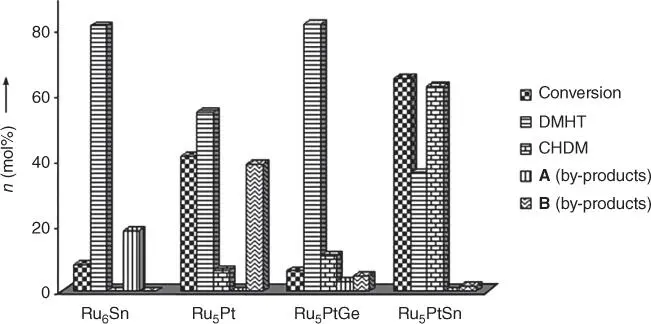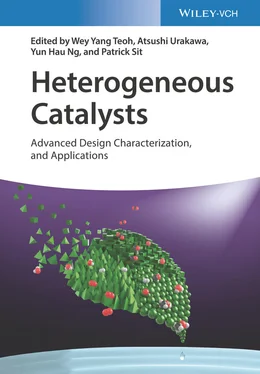
Figure 5.7 Bar chart comparing the activity and selectivity of the Ru 5PtSn catalyst with those of bi‐ and trimetallic analogues for the hydrogenation of dimethyl terephthalate.
Source: Hungria et al. 2006 [36]. Reproduced with permission of John Wiley & Sons.
This chapter has covered atomically precise metal clusters made using physical (UHV) and chemical approaches. Catalysts containing cluster‐like species as active sites with respect to their size regime (e.g. sub‐3 nm) can be made using conventional methods, but in this case, it is rare that atomic precision is reliably achieved as a range of cluster sizes can be formed since such methods lack precise control over particle size. Deposition–precipitation using heated solutions containing urea, which gradually decomposes, releasing ammonia that slowly increases the pH, seems to be promising method for making supported metal clusters [80].
One interesting area of making cluster‐based catalysts is focused on fabrication of clusters in porous materials, such as zeolites [81] and metal–organic framework materials [82] (see Chapters 7and 8). The idea is that growth of the clusters (starting from simple mono‐atomic precursors) is confined by the size of the cavities available. Although the chemistry of clusters in zeolites is well developed with an additional bonus of clusters interacting with H +in forming metal cluster‐proton adducts acting as “collapsed bifunctional sites” capable of both acid and redox catalysis [81], true atomic precision of such species can be hard to achieve. Recently, the [Cu 3(μ‐O) 3] 2+cluster in zeolites attracted significant attention owing to the interesting catalytic chemistry in the conversion of methane to methanol [83, 84]. Yet, there are studies that demonstrate that the presence of larger CuO xparticles (up to 3 nm) in such catalysts could also be active [85, 86].
Clusters supported within zeolites can undergo dynamic particle changes during catalysis, as was demonstrated by detailed high‐resolution electron microscopy study of Pt clusters in zeolite MCM‐22 [87]. In fact, it may be questionable if zeolite frameworks can truly limit cluster growth since it was demonstrated that the formation of truly large NPs within zeolite crystals does damage zeolite frameworks. Interestingly, such damage coincided with increased catalytic performance, which was interpreted as improvement of the mass transport‐limited reaction (by overcoming the narrow pores of the zeolite framework) [88]. Finally, clusters assembled in metal–organic framework materials could potentially become new high‐intensity research area due to molecular‐based nature of the framework complementing atomic precision of metal clusters [82]. There is evidence of promising high stability of such catalysts [82]. Ultimately, the control over cluster assembly with the help of functional groups built within a framework could be achieved with clever design of the framework.
1 1 Ertl, G., Knözinger, H., Schüth, F., and Weitkamp, J. (2008). Preface. In: Handbook of Heterogeneous Catalysis, vol. 1 (eds. G. Ertl, H. Knözinger, F. Schüth and J. Weitkamp). Wiley‐VCH.
2 2 Valden, M., Lai, X., and Goodman, D.W. (1998). Onset of catalytic activity of gold clusters on titania with the appearance of nonmetallic properties. Science 281 (5383): 1647–1650.
3 3 Higaki, T., Zhou, M., Lambright, K.J. et al. (2018). Sharp transition from nonmetallic Au246 to metallic Au279 with nascent surface plasmon resonance. J. Am. Chem. Soc. 140 (17): 5691–5695.
4 4 Vajda, S. and White, M.G. (2015). Catalysis applications of size‐selected cluster deposition. ACS Catal. 5 (12): 7152–7176.
5 5 Wegner, K., Piseri, P., Tafreshi, H.V., and Milani, P. (2006). Cluster beam deposition: a tool for nanoscale science and technology. J. Phys. D: Appl. Phys. 39 (22): R439.
6 6 Gruene, P., Rayner, D.M., Redlich, B. et al. (2008). Structures of neutral Au7, Au19, and Au20 clusters in the gas phase. Science 321 (5889): 674–676.
7 7 Smolanoff, J., L/apicki, A., and Anderson, S.L. (1995). Use of a quadrupole mass filter for high energy resolution ion beam production. Rev. Sci. Instrum. 66 (6): 3706–3708.
8 8 Sanchez, A., Abbet, S., Heiz, U. et al. (1999). When gold is not noble: nanoscale gold catalysts. J. Phys. Chem. A 103 (48): 9573–9578.
9 9 Halder, A., Curtiss, L.A., Fortunelli, A., and Vajda, S. (2018). Perspective: size selected clusters for catalysis and electrochemistry. J. Chem. Phys. 148 (11): 110901‐1–110901‐15.
10 10 Tyo, E.C. and Vajda, S. (2015). Catalysis by clusters with precise numbers of atoms. Nat. Nanotechnol. 10 (7): 577–588.
11 11 Heiz, U., Sanchez, A., Abbet, S., and Schneider, W.D. (1999). Catalytic oxidation of carbon monoxide on monodispersed platinum clusters: each atom counts. J. Am. Chem. Soc. 121 (13): 3214–3217.
12 12 Yoon, B., Häkkinen, H., Landman, U. et al. (2005). Charging effects on bonding and catalyzed oxidation of CO on Au8 clusters on MgO. Science 307 (5708): 403–407.
13 13 Landman, U., Yoon, B., Zhang, C. et al. (2007). Factors in gold nanocatalysis: oxidation of CO in the non‐scalable size regime. Top. Catal. 44 (1–2): 145–158.
14 14 Thostrup, P., Vestergaard, E.K., An, T. et al. (2003). CO‐induced restructuring of Pt(110)‐(1×2): bridging the pressure gap with high‐pressure scanning tunneling microscopy. J. Chem. Phys. 118 (8): 3724–3730.
15 15 Baxter, E.T., Ha, M.‐A., Cass, A.C. et al. (2017). Ethylene dehydrogenation on Pt4,7,8 clusters on Al2O3: strong cluster size dependence linked to preferred catalyst morphologies. ACS Catal. 7 (5): 3322–3335.
16 16 Schweinberger, F.F., Berr, M.J., Döblinger, M. et al. (2013). Cluster size effects in the photocatalytic hydrogen evolution reaction. J. Am. Chem. Soc. 135 (36): 13262–13265.
17 17 Nesselberger, M., Roefzaad, M., Fayçal Hamou, R. et al. (2013). The effect of particle proximity on the oxygen reduction rate of size‐selected platinum clusters. Nat. Mater. 12 (10): 919–924.
18 18 Kwon, G., Ferguson, G.A., Heard, C.J. et al. (2013). Size‐dependent subnanometer Pd cluster (Pd4, Pd6, and Pd17) water oxidation electrocatalysis. ACS Nano 7 (7): 5808–5817.
19 19 Liu, C., Yang, B., Tyo, E. et al. (2015). Carbon dioxide conversion to methanol over size‐selected Cu4 clusters at low pressures. J. Am. Chem. Soc. 137 (27): 8676–8679.
20 20 Negreiros, F.R., Halder, A., Yin, C. et al. (2018). Bimetallic Ag–Pt sub‐nanometer supported clusters as highly efficient and robust oxidation catalysts. Angew. Chem. Int. Ed. 57 (5): 1209–1213.
21 21 Cotton, F.A. (1966). Transition‐metal compounds containing clusters of metal atoms. Q. Rev. Chem. Soc. 20 (3): 389–401.
22 22 Cotton, F.A. (1964). Metal atom clusters in oxide systems. Inorg. Chem. 3 (9): 1217–1220.
23 23 Cotton, F.A. (1981). Metal–metal multiple bonds and metal clusters. In: Reactivity of Metal–Metal Bonds, vol. 155 (ed. M.H. Chisholm), 1–16. American Chemical Society.
24 24 Dyson, P. and McIndoe, S. (2000). Transition Metal Carbonyl Cluster Chemistry, vol. 2. CRC Press.
25 25 Dyson, P.J. (2004). Catalysis by low oxidation state transition metal (carbonyl) clusters. Coord. Chem. Rev. 248 (21): 2443–2458.
26 26 Ciabatti, I., Femoni, C., Iapalucci, M.C. et al. (2014). Platinum carbonyl clusters chemistry: four decades of challenging nanoscience. J. Cluster Sci. 25 (1): 115–146.
27 27 McKenzie, L.C., Zaikova, T.O., and Hutchison, J.E. (2014). Structurally similar triphenylphosphine‐stabilized undecagolds, Au11(PPh3)7Cl3 and [Au11(PPh3)8Cl2]Cl, exhibit distinct ligand exchange pathways with glutathione. J. Am. Chem. Soc. 136 (38): 13426–13435.
Читать дальше


